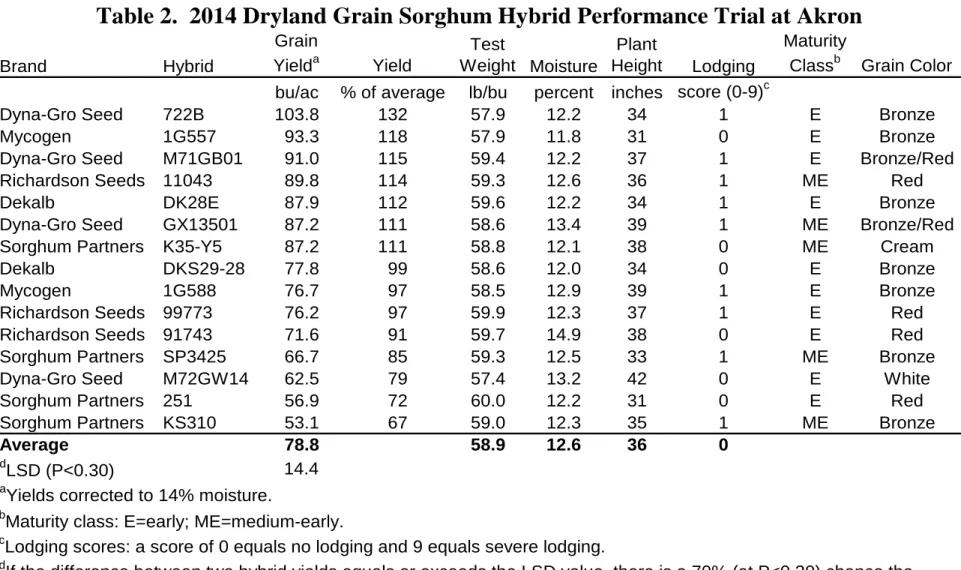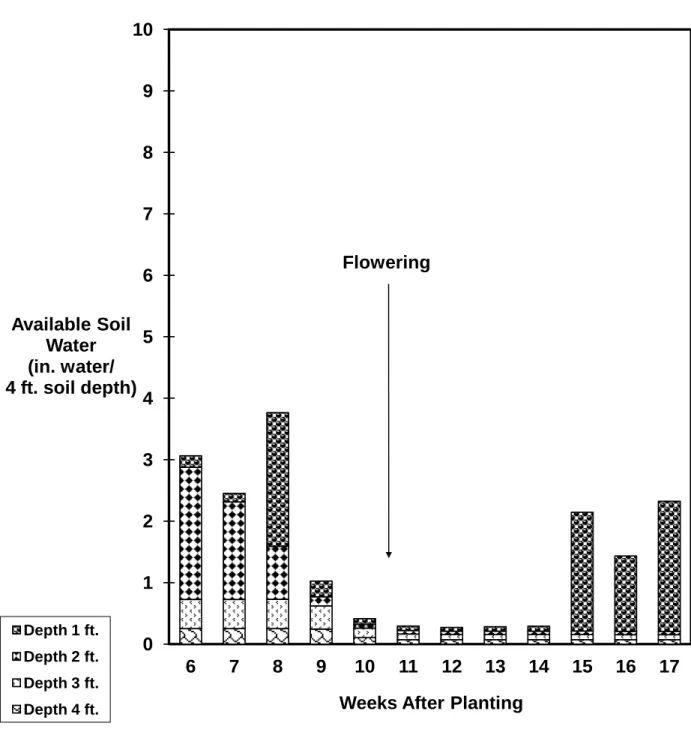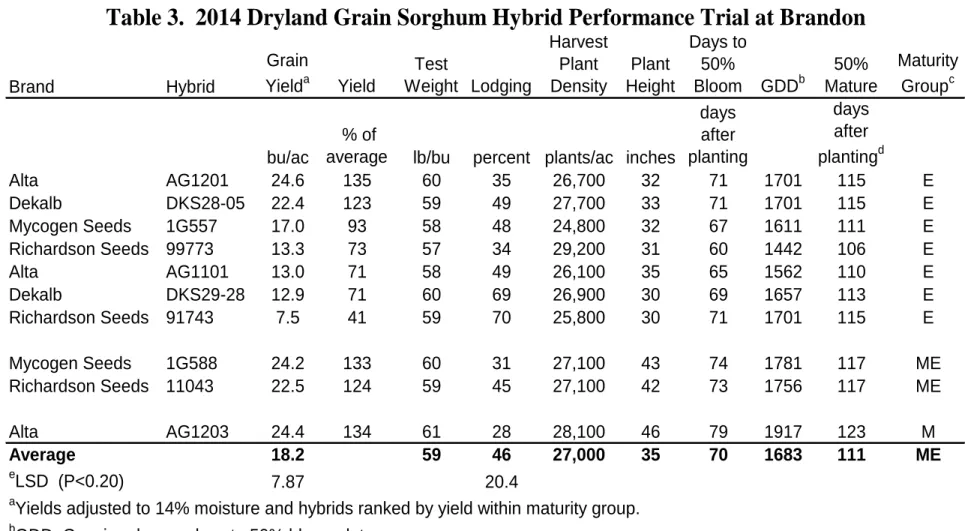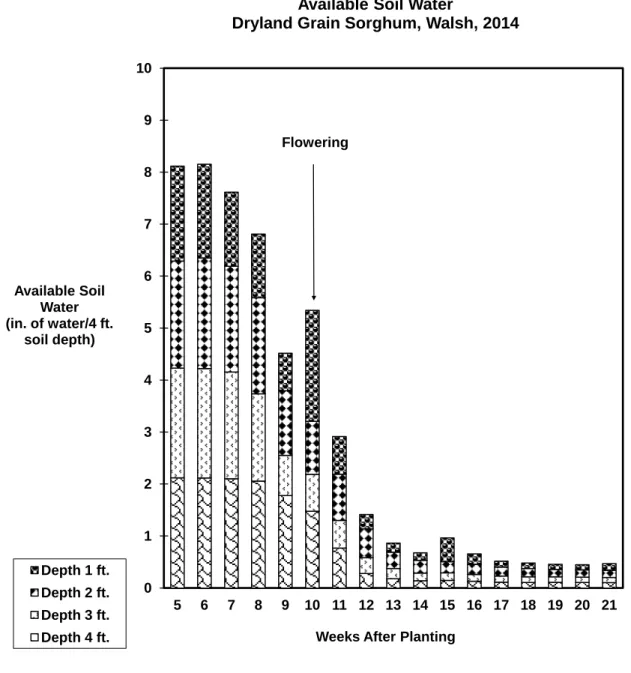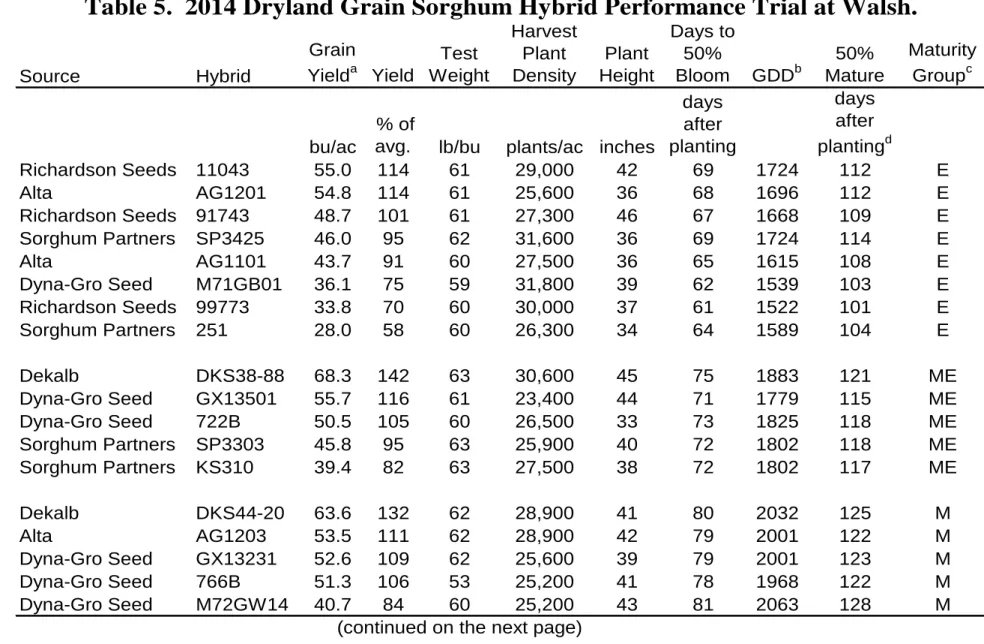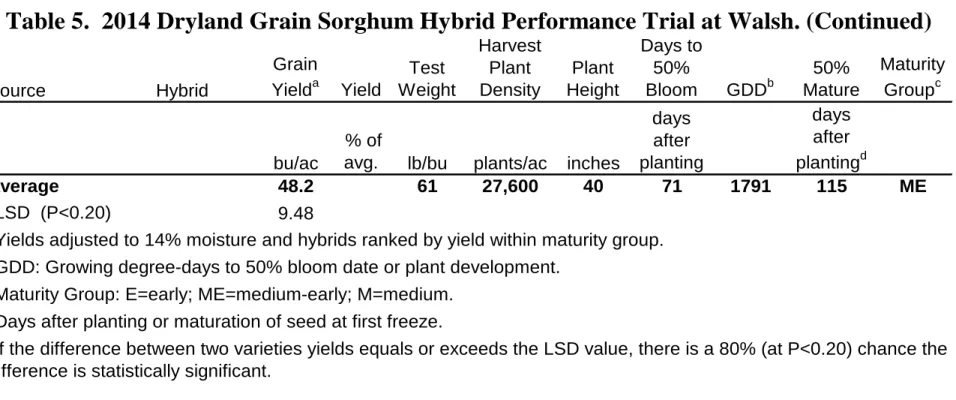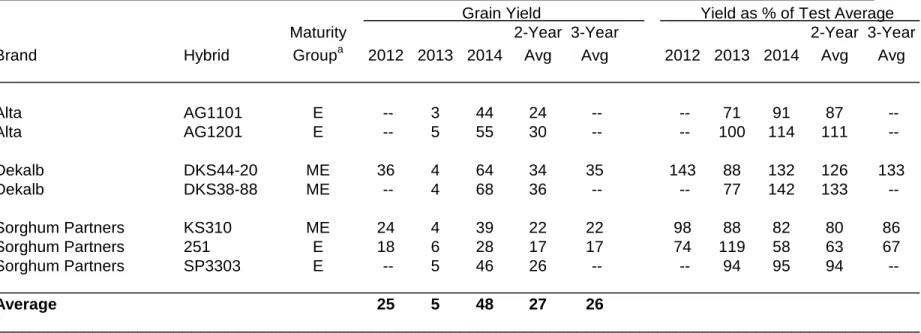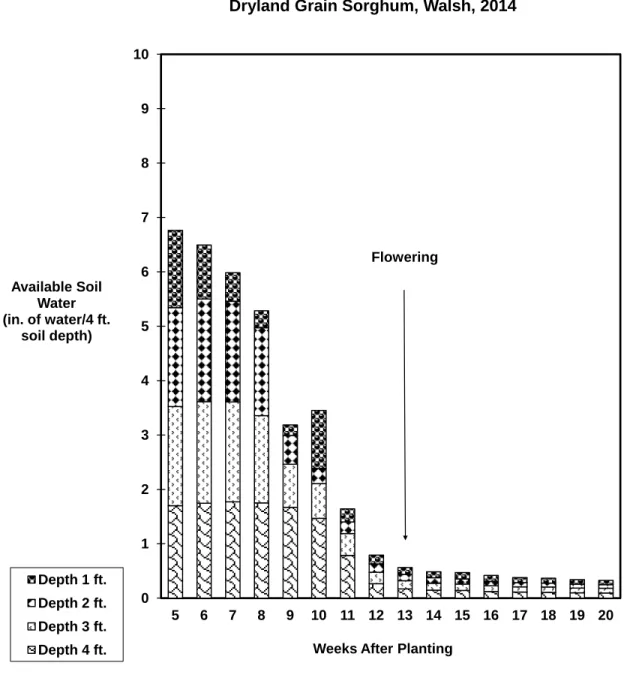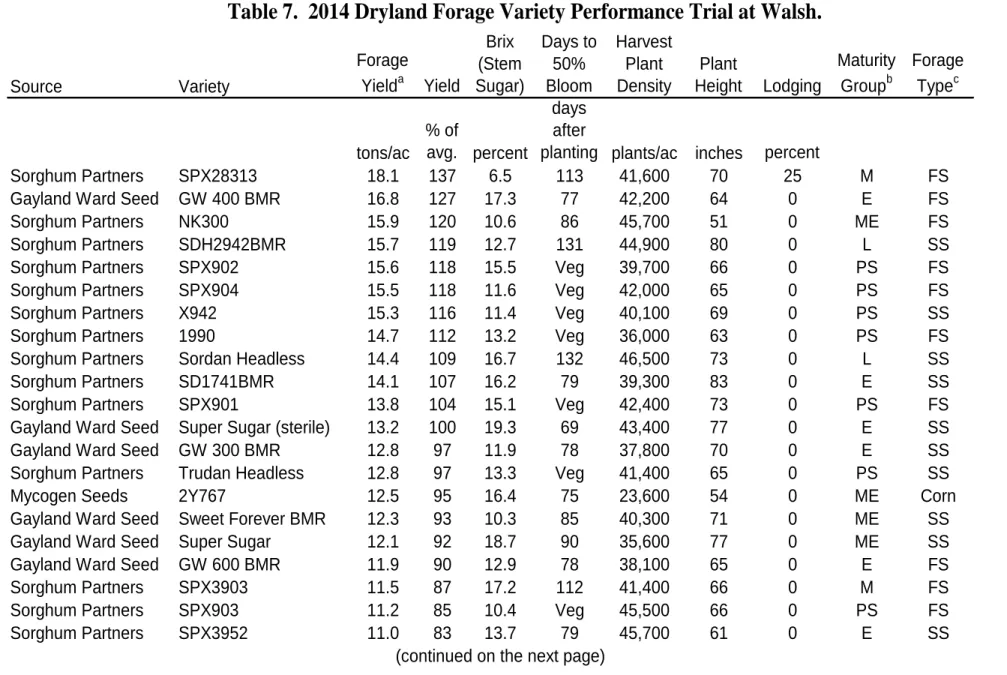Technical Report TR15-1 January 2015
Ag
ricultural
Experiment Station
College of Agricultural Sciences Department of Soil and Crop SciencesExtension Plainsman Research Center
2014 Sorghum Hybrid Performance
Trials in Eastern Colorado
K. J. Larson, Superintendent and Research Scientist II, Plainsman Research Center J. J. Johnson, Associate Professor and Extension Specialist, Dept. of Soil and Crop
Sciences
M. E. Bartolo, Manager and Senior Research Scientist, Arkansas Valley Research Center
S. M. Sauer, Research Associate, Dept. of Soil and Crop Sciences B. T. Pettinger, Research Associate, Plainsman Research Center K. J. Tanabe, Research Associate III, Arkansas Valley Research Center
Funded by the National Sorghum Producers, the Colorado Sorghum Producers and the Colorado Agricultural Experiment Station,
Crop Management and Sorghum Improvement, USDA, NIFA Project No. COL00654
This institution is an equal opportunity provider and employer.
• **Mention of a trademark or proprietary product does not constitute endorsement by the Colorado Agricultural Experiment Station.**
Colorado State University is an equal opportunity/affirmative action institution and complies with all Federal and Colorado State laws, regulations, and executive orders regarding affirmative action requirements in all programs. The Office of Equal Opportunity is located in 101 Student Services. In order to assist Colorado State University in meeting its affirmative action responsibilities, ethnic minorities, women, and other protected class members are encouraged to apply and to so identify themselves.
2014 SORGHUM HYBRID PERFORMANCE TRIALS IN EASTERN COLORADO
Page Introduction:
Seed Companies that Participated in Trials 2 Experimental Methods and Evaluations 3
Statistical Method 4
Acknowledgments 4
References 5
Dryland Grain Sorghum Hybrid Performance Trial at Akron 6 Dryland Grain Sorghum Hybrid Performance Trial at Brandon 8 Dryland Grain Sorghum Hybrid Performance Trial at Walsh 12 Dryland Forage Sorghum Performance Trial at Walsh 17 Irrigated Forage Sorghum Performance Trial at Rocky Ford 23
SORGHUM HYBRID PERFORMANCE TRIALS IN EASTERN COLORADO, 2014 K.J. Larsona, J.J. Johnsonb, M.E. Bartoloc, S.M. Sauerd, B.T. Pettingere, K.J. Tanabef
The 2014 Colorado grain sorghum crop was estimated at 7.50 million bushels, 30 percent larger than the 2013 sorghum crop of 5.76 million bushels. For Colorado, the 2014 grain sorghum crop of 7.50 million bushels was the second largest in the last 10 years. The increase in sorghum production this year was due to the highest harvested acres (250,000) for the last 10 years. The grain yield this year was estimated at 30.0 bu/acre, which was 6 bu/acre more than last year, but 1.8 bu/acre less than the 10 year average. As the production and yield levels indicate, conditions in Eastern Colorado for 2014 were more normal with most areas experiencing drought relief and improvements in precipitation. Sorghum silage statistics are not published during the current year; however, Colorado sorghum silage statistics are available for last year. In 2013, 390,000 tons of sorghum silage was produced. The average yield was 13 tons/acre from 30,000 harvested acres. (USDA and National Agricultural Statistics Service, Colorado Field Office, 2014).
This publication is a progress report of the sorghum hybrid performance trials conducted by the Department of Soil and Crop Sciences at Colorado State University, Colorado Agricultural Experiment Station (AES), and Colorado State University
Extension. The grain sorghum trials were conducted at three sites in eastern Colorado: Akron, Brandon, and Walsh. Forage sorghum trials were conducted at Rocky Ford (irrigated) and at Walsh (dryland).
Tests are partially funded by entry fees paid by commercial firms. Commercial seed representatives interested in entering sorghum hybrids in any of the trials should contact Jerry Johnson, phone (970) 491-1454, email Jerry.Johnson@colostate.edu; or Kevin Larson, phone (719) 324-5643, email Kevin.Larson@colostate.edu
for further details. Names and addresses of firms submitting entries in 2014 are shown in Table 1. Each firm selected entries for testing and furnished seed for the trials. AES researchers selected closed-pedigree hybrids as standards of comparison.
Summary tables for weather data (CoAgMet and NOAA, 2014), soil analysis (Soil, Plant and Water Testing Laboratory, Colorado State University), fertilization, and available soil water graphs derived from gypsum block readings are provided for certain trial locations. Other information, where available, was included: site description,
irrigation, pest control, field history, and pertinent comments.
aSuperintendent and Research Scientist II, Plainsman Research Center, Walsh; bAssociate Professor and Extension Specialist, Dept. of Soil and Crop Sciences; cManager and Senior Research Scientist, Arkansas Valley Research Center, Rocky Ford;
dResearch Associate, Dept. of Soil and Crop Sciences; eResearch Associate, Plainsman Research Center, Walsh; fResearch Associate, Arkansas Valley Research Center
Table 1.--Entrants in the 2014 Colorado Sorghum Performance Trials.
_____________________________________________________________________
Brand Entered by
ALTA Advanta US, 301 South Polk, Suite 350, Amarillo, TX 79105
DEKALB Monsanto Company, 800 N. Lindbergh Blvd., St. Louis, MO 63167
DYNA-GRO SEED Crop Production Services, 3005 Rocky Mountain Ave., Loveland, CO 80538
GAYLAND WARD SEED Gayland Ward Seed Co. Inc., 4395 US Hwy 60, Hereford, TX 79045
MYCOGEN SEEDS Mycogen Seeds, 9330 Zionsville Rd., Indianapolis, IN 46268
RICHARDSON SEEDS Richardson Seeds, Ltd., P.O. Box 60, 3095 CR 26, Vega, TX 79092
SORGHUM PARTNERS Chromatin, Inc., 8509 Venita Ave., Lubbock, TX 79424
Growing Degree Days for sorghum were calculated from planting through first freeze using a maximum of 111oF and a minimum of 50oF for threshold temperatures (Peacock and Heinrich, 1984). They are calculated by averaging daily high and low temperatures and subtracting the base temperature of 50oF from the average. When daily temperatures are less than 50oF, 50oF is used, when temperatures are above 111oF a maximum temperature of 111oF is used:
(Daily Minimum Temp. + Daily Maximum Temp.) 2
- 50oF
Experimental Methods and Evaluations
Trials were planted with a four-row cone planter and harvested with a modified, self-propelled John Deere 4420 combine equipped with a four-row row-crop head to enhance harvest of lodged tillers. Sorghum forage was cut and chopped with a single row John Deere 8 silage cutter.
Days to Emergence. Seedling emergence was determined as the number of days after planting until approximately half of the seedlings become visible down a planted row. 50% Bloom. Number of days after planting until half of the main heads had pollinating florets. Number of days to half bloom provides a good measure of relative maturity between hybrids.
50% Maturity. Number of days after planting until half of the kernels in half of the main heads reached physiological maturity, i.e., the black layer becomes visible at the base of the kernel.
Plant Height. Plant height was measured in inches from the soil to the tip of the main head.
Lodging. The percentage of tillers with broken basal stems or broken peduncles or were leaning more than a 45 degree angle were considered lodged. Since the combine was equipped with a row crop head, most of the leaning tillers were harvested.
Harvest Density. Plant population in plants per acre was counted prior to harvest. Test Weight. Test weight was determined using a hand-held bushel weight tester. A low test weight indicates that a hybrid did not fully mature prior to the first freeze or that it suffered environmental stress, such as a water deficiency.
Grain Yield. The grain yield in bushels per acre was adjusted to 14 percent moisture content.
Yield as a % of Test Average. Yield as a percentage of test average provides a comparison between yields within a trial and allows easy comparisons among years, irrespective of annual growing conditions.
Forage Yield. Forage yield in tons per acre was adjusted to 70% moisture content. A representative sample of fresh silage was oven-dried at 167oF (75oC) until there was no more weight loss, and then yields were adjusted to 70% moisture content.
Stem Sugar. The sugar content (Brix), expressed as a percent, in the stem of forage sorghums at harvest was measured with a hand refractometer.
Available Soil Water
Available soil water was measured by placing gypsum blocks at 6, 18, 30, and 42 inches below the soil surface. Electrical resistance readings were made weekly or biweekly. Resistance readings vary with the amount of soil water present. Using resistance readings, available soil water was determined by extrapolating from soil water depletion curves for each particular soil type.
Statistical Method
Trials were planted in a randomized complete block design with four replications. No less than three replications were harvested. Analysis of variance was applied to the results and the least significant difference (LSD) was computed at alpha = 0.20 or 0.30 for all trials. Analysis of variance and regression were performed with CoStat Statistical Software a product of Cohort Software, Berkeley, California.
Acknowledgements
We are sincerely grateful to the National Sorghum Producers for providing funding through the Colorado Sorghum Producers to support these performance trials. We are also appreciative to the staffs at the Central Great Plains Research Station at Akron, Arkansas Valley Research Center at Rocky Ford, and Plainsman Research Center at Walsh for their assistance in conducting these trials. We would like to extend a special thank you to Burl Scherler, grower-cooperator, for his assistance with the Brandon trial.
References
National Agricultural Statistics Service, Colorado Field Office. 2014. Colorado agricultural statistics 2014. USDA, NASS, CDA. 55p.
NOAA, May-October, 2014. Climatological data, Colorado. vol. 119, no.5-10. NOAA, Dept. of Commerce, NWS, NESDIS, NCDC.
Peacock, J.M. and G.M. Heinrich. 1984. Light and temperature response in sorghum. pp. 143-158. In: Agrometeorology of Sorghum and Millet in the Semi-Tropics: Proceedings of the International Symposium. November 15-20, 1982. India, ICRISAT, WMO.
USDA, National Agricultural Statistics Service. November 10, 2014. Crop production report. USDA, NASS. 63p.
Dryland Grain Sorghum Performance Trial at Akron, 2014 COOPERATOR: USDA-ARS Central Great Plains Research Station.
PURPOSE: To identify high yielding hybrids under dryland conditions with 2800 sorghum heat units in a silt loam soil.
PLOT: Four rows with 30 in. row spacing, 35 ft. long. SEEDING
DENSITY: 43,600 seed/ac. PLANTED: May 19. HARVESTED: November 21. PEST CONTROL: Preemergence Herbicides: Lumax and Glyphosate. Cultivation: None. Insecticides: None.
SOIL: Rago silt loam.
FERTILIZER: Nitrogen 60 lb/ac. FIELD HISTORY: Last Crop: Wheat.
FIELD PREPARATION: No-till.
COMMENTS: Planted into good soil moisture and received 1.5 inches of rain the week following planting. Trial had consistent stands and very good emergence. Weed
control was good throughout the season. Temperatures were mild and the trial received well above-average precipitation during the growing season. Rain events were well-timed, which resulted in high yields.
Summary: Growing Season Precipitation and Temperature Akron, Washington County.a
__________________________________________________ Month Rainfall GDDb >90 F >100 F DAPc __________________________________________________ In ---no. of days--- May 2.19 201 0 0 12 June 3.29 492 3 0 42 July 2.42 714 15 1 73 August 4.77 664 6 0 104 September 3.44 469 2 0 134 October 0.23 280 0 0 161 Total 16.34 2820 26 1 161 _________________________________________________ a
Growing season from May 19 (planting) to October 27 (first freeze, 28F).
b
GDD: Growing Degree Days for sorghum.
c
Brand Hybrid Grain Yielda Yield Test Weight Moisture Plant Height Lodging Maturity
Classb Grain Color bu/ac % of average lb/bu percent inches score (0-9)c
Dyna-Gro Seed 722B 103.8 132 57.9 12.2 34 1 E Bronze
Mycogen 1G557 93.3 118 57.9 11.8 31 0 E Bronze
Dyna-Gro Seed M71GB01 91.0 115 59.4 12.2 37 1 E Bronze/Red
Richardson Seeds 11043 89.8 114 59.3 12.6 36 1 ME Red
Dekalb DK28E 87.9 112 59.6 12.2 34 1 E Bronze
Dyna-Gro Seed GX13501 87.2 111 58.6 13.4 39 1 ME Bronze/Red
Sorghum Partners K35-Y5 87.2 111 58.8 12.1 38 0 ME Cream
Dekalb DKS29-28 77.8 99 58.6 12.0 34 0 E Bronze
Mycogen 1G588 76.7 97 58.5 12.9 39 1 E Bronze
Richardson Seeds 99773 76.2 97 59.9 12.3 37 1 E Red
Richardson Seeds 91743 71.6 91 59.7 14.9 38 0 E Red
Sorghum Partners SP3425 66.7 85 59.3 12.5 33 1 ME Bronze
Dyna-Gro Seed M72GW14 62.5 79 57.4 13.2 42 0 E White
Sorghum Partners 251 56.9 72 60.0 12.2 31 0 E Red
Sorghum Partners KS310 53.1 67 59.0 12.3 35 1 ME Bronze
Average 78.8 58.9 12.6 36 0
d
LSD (P<0.30) 14.4
a
Yields corrected to 14% moisture.
Table 2. 2014 Dryland Grain Sorghum Hybrid Performance Trial at Akron
b
Maturity class: E=early; ME=medium-early. c
Lodging scores: a score of 0 equals no lodging and 9 equals severe lodging. d
If the difference between two hybrid yields equals or exceeds the LSD value, there is a 70% (at P<0.30) chance the difference is statistically significant.
Dryland Grain Sorghum Hybrid Performance Trial at Brandon, 2014 COOPERATOR: Burl Scherler, Sand Creek, Inc., Brandon, Colorado.
PURPOSE: To identify high yielding hybrids under dryland conditions with 2730 sorghum heat units in loam soil.
PLOT: Four rows with 30 in. row spacing, 50 ft. long. SEEDING
DENSITY: 43,600 seed/a. PLANTED: June 2. HARVESTED: November 14. PEST CONTROL: Preemergence Herbicides: Post Emergence
Herbicides: Huskie 16 oz/a, Atrazine 0.75 lb/a. Cultivation: None.
Insecticides: None.
FIELD HISTORY: Previous Crop: Sorghum. FIELD PREPARATION: No-till.
COMMENTS: Planted in marginal soil moisture, but it rained shortly after planting. Weed control was poor with volunteer sorghum and kochia predominating (the crop emerged rapidly, which prevented preemergence herbicide application) . Precipitation for the growing season was about one inch below the average of the past 28 years. June was dry, but the rest of the monthly precipitation totals for the growing season were near their long term averages. No greenbug infestation. Yields and test weights were fair, especially considering the lack of early season precipitation and heavy weed pressure.
SOIL: Loam for 0-8” and loam 8”-24” depths from soil analysis.
Summary: Growing Season Precipitation and Temperature Chivington, Kiowa County.a
__________________________________________________ Month Rainfall GDDb >90 F >100 F DAPc
__________________________________________________ In ---no. of days--- June 1.88 640 14 2 28 July 2.45 784 18 10 59 August 2.48 751 19 0 90 September 1.13 524 7 1 120 October 0.00 29 0 0 123 Total 7.94 2728 58 13 123 _________________________________________________ a
Growing season from June 2 (planting) to October 3 (first freeze, 30 F).
b
GDD: Growing Degree Days for sorghum.
cDAP: Days After Planting.
Summary: Fertilization. ____________________________________________ Fertilizer N P2O5 Zn Fe ____________________________________________ ---lb/a--- Recommended 0 20 0 0 Applied 50 20 0 0 ____________________________________________ Yield Goal: 30 bu/a.
Actual Yield: 18 bu/a. Summary: Soil Analysis of Plant Available Nutrients.
_____________________________________________________ Depth pH Salts OM N P K Zn Fe _____________________________________________________ mmhos/cm % ---ppm--- 0-8” 7.8 0.4 1.5 8 5.0 462 0.5 2.2 8”-24” 8
Comment Alka VLo Mod Mod Lo VHi Lo Lo _____________________________________________________ Manganese and Copper levels were adequate.
0 1 2 3 4 5 6 7 8 9 10 6 7 8 9 10 11 12 13 14 15 16 17 Available Soil Water (in. water/ 4 ft. soil depth)
Weeks After Planting
Available Soil Water
Dryland Grain Sorghum, Brandon, 2014
Depth 1 ft. Depth 2 ft. Depth 3 ft. Depth 4 ft.
Flowering
Fig. 1. Available soil water in dryland grain sorghum at Brandon. Gypsum block
measurements taken to 4 ft. with 1 ft. increments. Total rainfall at Brandon from planting to first freeze was 7.94 in. Any increase in available soil water
Brand Hybrid Grain Yielda Yield Test Weight Lodging Harvest Plant Density Plant Height Days to 50% Bloom GDDb 50% Mature Maturity Groupc bu/ac % of
average lb/bu percent plants/ac inches
days after planting days after plantingd Alta AG1201 24.6 135 60 35 26,700 32 71 1701 115 E Dekalb DKS28-05 22.4 123 59 49 27,700 33 71 1701 115 E Mycogen Seeds 1G557 17.0 93 58 48 24,800 32 67 1611 111 E Richardson Seeds 99773 13.3 73 57 34 29,200 31 60 1442 106 E Alta AG1101 13.0 71 58 49 26,100 35 65 1562 110 E Dekalb DKS29-28 12.9 71 60 69 26,900 30 69 1657 113 E Richardson Seeds 91743 7.5 41 59 70 25,800 30 71 1701 115 E Mycogen Seeds 1G588 24.2 133 60 31 27,100 43 74 1781 117 ME Richardson Seeds 11043 22.5 124 59 45 27,100 42 73 1756 117 ME Alta AG1203 24.4 134 61 28 28,100 46 79 1917 123 M Average 18.2 59 46 27,000 35 70 1683 111 ME e LSD (P<0.20) 7.87 20.4 a
Yields adjusted to 14% moisture and hybrids ranked by yield within maturity group. b
GDD: Growing degree-days to 50% bloom date. c
Maturity Group: E=early; ME=medium-early; M=medium. d
Days after planting or maturation of seed at first freeze.
Table 3. 2014 Dryland Grain Sorghum Hybrid Performance Trial at Brandon
e
If the difference between two varieties yields equals or exceeds the LSD value, there is a 80% (at P<0.20) chance the difference is statistically significant.
Table 4. Summary: Dryland Grain Sorghum Hybrid Performance Trials at Brandon, 2012-2014.
___________________________________________________________________________________________________________
Grain Yield Yield as % of Test Average
Maturity 2-Year 3-Year 2-Year 3-Year
Brand Hybrid Groupa 2012 2013 2014 Avg Avg 2012 2013 2014 Avg Avg ______________________________________________________________________________________________________ Alta AG1101 E -- 17 13 15 -- -- 119 71 88 --Alta AG1201 E -- 17 25 21 -- -- 114 135 124 --Dekalb DKS29-28 E 45 24 13 19 27 133 166 71 109 124 Dekalb DKS28-05 E 40 12 22 17 25 118 84 123 100 112 Mycogen Seeds 1G557 E 45 18 17 18 27 131 124 93 103 121 ______________________________________________________________________________________________________ Average 34 15 18 17 22 ______________________________________________________________________________________________________ a
Maturity Group: E=early.
Dryland Grain Sorghum Hybrid Performance Trial at Walsh, 2014 COOPERATOR: Plainsman Agri-Search Foundation, Walsh, Colorado.
PURPOSE: To identify high yielding hybrids under dryland conditions with 3300 sorghum heat units in a silt loam soil.
PLOT: Four rows with 30 in. row spacing, 50 ft. long. SEEDING
DENSITY: 43,600 seed/a. PLANTED: May 30. HARVESTED: November 5. PEST CONTROL: Preemergence Herbicides: Atrazine 1lb/a, Medal 21 oz/a, Glyphosate, 32 oz/a; 2,4-D, 0.5 lb/a, Banvel 4 oz/a. Post Emergence Herbicides: Huskie 12 oz/a, 2,4-D 3.0 oz/a, Atrazine 0.75 lb/a, AMS 1 lb/a. Cultivation: None. Insecticides: None. FIELD HISTORY: Previous Crop:
Wheat. FIELD PREPARATION: Strip-till.
COMMENTS: Planted in adequate soil moisture. Weed control was excellent. No greenbug infestation. The growing season precipitation was nearly average and
generally well timed. Very long growing season with the first freeze date on October 31. Grain yields and test weights were very good.
SOIL: Richfield silt loam for 0-8” and silt loam 8”-24” depths from soil analysis.
Summary: Growing Season Precipitation and Temperature Walsh, Baca County.a
__________________________________________________ Month Rainfall GDDb >90 F >100 F DAPc __________________________________________________ In ---no. of days--- May 0.49 48 1 0 2 June 2.05 690 16 1 32 July 2.14 832 19 11 63 August 1.98 832 23 2 94 September 2.10 555 6 1 124 October 1.27 347 0 0 155 Total 10.03 3304 65 15 155 _________________________________________________ a
Growing season from May 30 (planting) to October 31 (first freeze, 29 F).
b
GDD: Growing Degree Days for sorghum.
c
DAP: Days After Planting.
Summary: Fertilization. ____________________________________________ Fertilizer N P2O5 Zn Fe ____________________________________________ ---lb/a--- Recommended 0 20 0 0 Applied 50 20 0 0 ____________________________________________ Yield Goal: 40 bu/a.
Actual Yield: 48 bu/a. Summary: Soil Analysis of Plant Available Nutrients.
_____________________________________________________ Depth pH Salts OM N P K Zn Fe _____________________________________________________ mmhos/cm % ---ppm--- 0-8” 7.9 0.6 1.5 20 7.0 395 0.7 2.7 8”-24” 17
Comment Alka VLo Mod Hi Lo VHi Lo Lo _____________________________________________________ Manganese and Copper levels were adequate.
0 1 2 3 4 5 6 7 8 9 10 5 6 7 8 9 10 11 12 13 14 15 16 17 18 19 20 21 Available Soil Water (in. of water/4 ft. soil depth)
Weeks After Planting
Available Soil Water
Dryland Grain Sorghum, Walsh, 2014
Depth 1 ft. Depth 2 ft. Depth 3 ft. Depth 4 ft.
Flowering
Fig. 2. Available soil water in dryland grain sorghum at Walsh. Gypsum block measurements taken to 4 ft. with 1 ft. increments. Total rainfall at Walsh from planting to first freeze was 10.03 in. Any increase in available soil water between weeks is from rain.
Source Hybrid Grain Yielda Yield Test Weight Harvest Plant Density Plant Height Days to 50% Bloom GDDb 50% Mature Maturity Groupc bu/ac % of
avg. lb/bu plants/ac inches
days after planting days after plantingd Richardson Seeds 11043 55.0 114 61 29,000 42 69 1724 112 E Alta AG1201 54.8 114 61 25,600 36 68 1696 112 E Richardson Seeds 91743 48.7 101 61 27,300 46 67 1668 109 E Sorghum Partners SP3425 46.0 95 62 31,600 36 69 1724 114 E Alta AG1101 43.7 91 60 27,500 36 65 1615 108 E Dyna-Gro Seed M71GB01 36.1 75 59 31,800 39 62 1539 103 E Richardson Seeds 99773 33.8 70 60 30,000 37 61 1522 101 E Sorghum Partners 251 28.0 58 60 26,300 34 64 1589 104 E Dekalb DKS38-88 68.3 142 63 30,600 45 75 1883 121 ME Dyna-Gro Seed GX13501 55.7 116 61 23,400 44 71 1779 115 ME Dyna-Gro Seed 722B 50.5 105 60 26,500 33 73 1825 118 ME Sorghum Partners SP3303 45.8 95 63 25,900 40 72 1802 118 ME Sorghum Partners KS310 39.4 82 63 27,500 38 72 1802 117 ME Dekalb DKS44-20 63.6 132 62 28,900 41 80 2032 125 M Alta AG1203 53.5 111 62 28,900 42 79 2001 122 M Dyna-Gro Seed GX13231 52.6 109 62 25,600 39 79 2001 123 M Dyna-Gro Seed 766B 51.3 106 53 25,200 41 78 1968 122 M Dyna-Gro Seed M72GW14 40.7 84 60 25,200 43 81 2063 128 M
(continued on the next page)
Source Hybrid Grain Yielda Yield Test Weight Harvest Plant Density Plant Height Days to 50% Bloom GDDb 50% Mature Maturity Groupc bu/ac % of
avg. lb/bu plants/ac inches
days after planting days after plantingd Average 48.2 61 27,600 40 71 1791 115 ME e LSD (P<0.20) 9.48 a
Yields adjusted to 14% moisture and hybrids ranked by yield within maturity group.
b
GDD: Growing degree-days to 50% bloom date or plant development.
c
Maturity Group: E=early; ME=medium-early; M=medium.
d
Days after planting or maturation of seed at first freeze.
Table 5. 2014 Dryland Grain Sorghum Hybrid Performance Trial at Walsh. (Continued)
e
If the difference between two varieties yields equals or exceeds the LSD value, there is a 80% (at P<0.20) chance the difference is statistically significant.
Table 6. Summary: Dryland Grain Sorghum Hybrid Performance Trials at Walsh, 2012-2014.
______________________________________________________________________________________________________________
Grain Yield Yield as % of Test Average Maturity 2-Year 3-Year 2-Year 3-Year Brand Hybrid Groupa 2012 2013 2014 Avg Avg 2012 2013 2014 Avg Avg ________________________________________________________________________________________________________ Alta AG1101 E -- 3 44 24 -- -- 71 91 87 --Alta AG1201 E -- 5 55 30 -- -- 100 114 111 --Dekalb DKS44-20 ME 36 4 64 34 35 143 88 132 126 133 Dekalb DKS38-88 ME -- 4 68 36 -- -- 77 142 133 --Sorghum Partners KS310 ME 24 4 39 22 22 98 88 82 80 86 Sorghum Partners 251 E 18 6 28 17 17 74 119 58 63 67 Sorghum Partners SP3303 E -- 5 46 26 -- -- 94 95 94 --________________________________________________________________________________________________________ Average 25 5 48 27 26 ________________________________________________________________________________________________________ a
Maturity Group: E=early; ME=medium early.
Dryland Forage Sorghum Performance Trial at Walsh, 2014 COOPERATOR: Plainsman Agri-Search Foundation, Walsh, Colorado.
PURPOSE: To identify high yielding hybrids under dryland conditions with 3100 sorghum heat units in a silt loam soil.
PLOT: Four rows with 30 in. row spacing, 50 ft. long. SEEDING
DENSITY: 69,700 seed/a. PLANTED: May 30. HARVESTED: October 15. PEST CONTROL: Preemergence Herbicides: Atrazine 1 lb/a, Glyphosate 32 oz/a, 2,4-D 0.5 lb/a, Dicamba 4 oz/a. Post Emergence Herbicides: Huskie 12 oz/a, 2,4-D 3.0 oz/a, Atrazine 0.75 lb/a, AMS 1 lb/a. Cultivation: None.
Insecticides: None.
FIELD HISTORY: Previous Crop:
Wheat. FIELD PREPARATION: Strip-till.
COMMENTS: Planted in adequate soil moisture. Weed control was excellent. No greenbug infestation. The growing season precipitation was nearly average and
generally well timed. Very long growing season with the first freeze date on October 31. Forage yields were very good.
SOIL: Richfield silt loam for 0-8” and silt loam 8”-24” depths from soil analysis.
Summary: Growing Season Precipitation and Temperature Walsh, Baca County.a
__________________________________________________ Month Rainfall GDDb >90 F >100 F DAPc __________________________________________________ In ---no. of days--- May 0.49 48 1 0 2 June 2.05 690 16 1 32 July 2.14 832 19 11 63 August 1.98 832 23 2 94 September 2.10 555 6 1 124 October 1.27 155 0 0 139 Total 10.03 3112 65 15 139 _________________________________________________ a
Growing season from May 30 (planting) to October 15 (harvest).
b
GDD: Growing Degree Days for sorghum.
c
DAP: Days After Planting.
Summary: Fertilization. ____________________________________________ Fertilizer N P2O5 Zn Fe ____________________________________________ ---lb/a--- Recommended 0 20 0 0 Applied 50 20 0 0 ____________________________________________ Yield Goal: 8 tons/a.
Actual Yield: 13.2 tons/a. Summary: Soil Analysis of Plant Available Nutrients.
_____________________________________________________ Depth pH Salts OM N P K Zn Fe _____________________________________________________ mmhos/cm % ---ppm--- 0-8” 7.9 0.6 1.5 20 7.0 395 0.7 2.7 8”-24” 17
Comment Alka VLo Hi Hi Lo VHi Lo Lo _____________________________________________________ Manganese and Copper levels were adequate.
0 1 2 3 4 5 6 7 8 9 10 5 6 7 8 9 10 11 12 13 14 15 16 17 18 19 20 Available Soil Water (in. of water/4 ft. soil depth)
Weeks After Planting
Available Soil Water
Dryland Grain Sorghum, Walsh, 2014
Depth 1 ft. Depth 2 ft. Depth 3 ft. Depth 4 ft.
Flowering
Fig. 3. Available soil water in dryland forage sorghum at Walsh. Gypsum block measurements taken to 4 ft. with 1 ft. increments. Total rainfall at Walsh from planting to harvest was 10.03 in. Any increase in available soil water
Source Variety Forage Yielda Yield Brix (Stem Sugar) Days to 50% Bloom Harvest Plant Density Plant Height Lodging Maturity Groupb Forage Typec tons/ac % of avg. percent days after
planting plants/ac inches percent
Sorghum Partners SPX28313 18.1 137 6.5 113 41,600 70 25 M FS
Gayland Ward Seed GW 400 BMR 16.8 127 17.3 77 42,200 64 0 E FS
Sorghum Partners NK300 15.9 120 10.6 86 45,700 51 0 ME FS
Sorghum Partners SDH2942BMR 15.7 119 12.7 131 44,900 80 0 L SS
Sorghum Partners SPX902 15.6 118 15.5 Veg 39,700 66 0 PS FS
Sorghum Partners SPX904 15.5 118 11.6 Veg 42,000 65 0 PS FS
Sorghum Partners X942 15.3 116 11.4 Veg 40,100 69 0 PS SS
Sorghum Partners 1990 14.7 112 13.2 Veg 36,000 63 0 PS FS
Sorghum Partners Sordan Headless 14.4 109 16.7 132 46,500 73 0 L SS
Sorghum Partners SD1741BMR 14.1 107 16.2 79 39,300 83 0 E SS
Sorghum Partners SPX901 13.8 104 15.1 Veg 42,400 73 0 PS FS
Gayland Ward Seed Super Sugar (sterile) 13.2 100 19.3 69 43,400 77 0 E SS
Gayland Ward Seed GW 300 BMR 12.8 97 11.9 78 37,800 70 0 E SS
Sorghum Partners Trudan Headless 12.8 97 13.3 Veg 41,400 65 0 PS SS
Mycogen Seeds 2Y767 12.5 95 16.4 75 23,600 54 0 ME Corn
Gayland Ward Seed Sweet Forever BMR 12.3 93 10.3 85 40,300 71 0 ME SS
Gayland Ward Seed Super Sugar 12.1 92 18.7 90 35,600 77 0 ME SS
Gayland Ward Seed GW 600 BMR 11.9 90 12.9 78 38,100 65 0 E FS
Sorghum Partners SPX3903 11.5 87 17.2 112 41,400 66 0 M FS
Sorghum Partners SPX903 11.2 85 10.4 Veg 45,500 66 0 PS FS
Sorghum Partners SPX3952 11.0 83 13.7 79 45,700 61 0 E SS
(continued on the next page)
Source Variety Forage Yielda Yield Brix (Stem Sugar) Days to 50% Bloom Harvest Plant Density Plant Height Lodging Maturity Groupb Forage Typec tons/ac % of avg. percent days after
planting plants/ac inches percent
Sorghum Partners SS405 10.9 83 8.9 96 39,700 86 30 M FS
Gayland Ward Seed Dwarf BMR 6 9.7 73 17.6 88 33,700 37 0 M FS
Sorghum Partners SPX3902 9.5 72 21.7 86 37,000 45 0 M FS
Gayland Ward Seed Sweet Six BMR 9.1 69 14.3 71 40,300 74 0 E SS
Average 13.2 14.1 90 40,200 67 2 M FS
d
LSD (P<0.20) 3.30
a
Yields are adjusted to 70% moisture content based on oven-dried samples. b
Relative Maturity: E=early; ME=medium early; M=medium; ML=medium late; L=late; PS=photoperiod sensitive. c
Forage Type: FS=forage sorghum; SS=sorghum sudangrass. d
If the difference between two varieties yields equals or exceeds the LSD value, there is a 80% (at P<0.20) chance that the difference is statistically significant.
Source Variety
Forage Typea
Days to
Boot RFV CP TDN ADF NDF Maint. Gain Lact.
Sorghum Partners Trudan Headless SS Veg 118 9.6 68.7 29.7 52.0 0.72 0.45 0.71
Sorghum Partners SDH2942BMR SS 122 115 10.6 69.0 29.4 53.4 0.73 0.45 0.71
Gayland Ward Seed Sweet Six BMR SS 64 114 14.7 71.2 27.5 54.8 0.76 0.48 0.74
Gayland Ward Seed Dwarf BMR 6 FS 83 111 15.4 71.1 27.6 56.4 0.76 0.48 0.74
Gayland Ward Seed GW 400 BMR FS 69 111 13.4 69.2 29.3 55.2 0.73 0.46 0.72
Sorghum Partners X942 SS Veg 111 11.0 67.3 30.9 54.5 0.70 0.43 0.70
Sorghum Partners Sordan Headless SS 123 110 11.2 69.5 29.0 55.9 0.74 0.46 0.72
Sorghum Partners SPX3903 FS 112 108 17.1 70.5 28.1 58.0 0.75 0.47 0.73
Sorghum Partners SPX3902 FS 79 107 14.6 68.4 29.9 57.1 0.72 0.45 0.71
Gayland Ward Seed GW 600 BMR FS 71 104 15.4 69.1 29.3 58.9 0.73 0.46 0.72
Sorghum Partners SS405 FS 87 104 15.4 69.1 29.4 58.8 0.73 0.46 0.72
Sorghum Partners SPX904 FS Veg 104 10.5 68.6 29.8 58.9 0.72 0.45 0.71
Sorghum Partners SPX902 FS Veg 104 9.7 68.6 29.8 58.7 0.72 0.45 0.71
Sorghum Partners SPX28313 FS 97 103 15.4 68.9 29.5 59.5 0.73 0.45 0.71
Sorghum Partners 1990 FS Veg 103 11.4 68.3 30.0 59.2 0.72 0.45 0.71
Sorghum Partners SPX3952 SS 72 101 15.8 68.3 30.0 60.4 0.72 0.45 0.71
Sorghum Partners SD1741BMR SS 70 101 14.8 67.9 30.4 60.3 0.71 0.44 0.70
Gayland Ward Seed Sweet Forever BMR SS 77 101 14.3 67.9 30.4 59.8 0.71 0.44 0.70
Gayland Ward Seed Super Sugar (sterile) SS 65 100 13.4 68.0 30.3 60.7 0.71 0.44 0.70
Sorghum Partners SPX903 FS Veg 100 9.8 66.6 31.5 60.0 0.69 0.42 0.69
Gayland Ward Seed Super Sugar SS 78 99 15.1 67.3 31.0 61.0 0.70 0.43 0.69
Sorghum Partners SPX901 FS Veg 99 9.4 66.6 31.5 60.4 0.69 0.42 0.69
(continued on the next page)
Table 8. 2014 Dryland Forage Sorghum Dry Matter Analysis at Walsh.
---MCal/lb---Net Energy
---percent---Source Variety
Forage Typea
Days to
Boot RFV CP TDN ADF NDF Maint. Gain Lact.
Mycogen Seeds 2Y767 Corn 71 97 15.9 66.8 31.3 61.5 0.70 0.43 0.70
Gayland Ward Seed GW 300 BMR SS 71 96 14.7 66.2 31.9 62.1 0.69 0.42 0.68 Sorghum Partners NK300 FS 81 96 13.9 66.2 31.9 62.2 0.69 0.42 0.68
Average 105 13.3 68.4 30.0 58.4 0.72 0.45 0.69
a
Forage Type: FS=forage sorghum; SS=sorghum sudangrass.
RFV=Relative Feed Value; CP=Crude Protein; TDN=Total Digestible Nutrients; ADF=Acid Detergent Fiber; NDF=Neutral Detergent Fiber.
Net Energy: Maintenance, Gain, Lactation.
Table 8. 2014 Dryland Forage Sorghum Dry Matter Analysis at Walsh (Continued).
Irrigated Forage Sorghum Hybrid Performance Trial at Rocky Ford, 2014 COOPERATOR: Arkansas Valley Research Center.
PURPOSE: To identify high yielding hybrids under irrigated conditions with 2150 sorghum heat units in a silty clay loam soil.
PLOT: Four rows with 30 in. row spacing, 35 ft. long. SEEDING
DENSITY: 113,250 seed/a. PLANTED: May 30; replanted: June 27.
HARVESTED: September 9.
IRRIGATION: Two furrow irrigations. PEST CONTROL: Preemergence Herbicides: None. Post Emergence Herbicides: None. Cultivation: Once. Insecticides: None.
SOIL: Rocky Ford silty clay loam. FERTILIZER: Manure at 20 tons/ac.
FIELD HISTORY: Previous Crop: Corn. FIELD PREPARATION: Disked and plowed. COMMENTS: Planted in adequate soil moisture for seed germination and stand establishment. Weed control was good. The growing season precipitation was above average, July was very wet. The forage yields were excellent.
Summary: Growing Season Precipitation and Temperature Rocky Ford, Otero County.a
__________________________________________________ Month Rainfall GDDb >90 F >100 F DAPc __________________________________________________ In ---no. of days--- May 0.21 45 0 0 2 June 1.97 675 15 0 32 July 5.07 600 17 3 63 August 1.12 660 17 0 94 September 0.01 163 4 1 103 Total 8.38 2143 53 4 103 _________________________________________________
aGrowing season from May 30 (planting) to September 9
(harvest).
b
GDD: Growing Degree Days for sorghum.
c
Brand Hybrid Forage Yielda Yield Brix (Stem Sugar) Days to Boot Harvest Plant Density Plant Height Relative Maturityb Forage Typec tons/ac % of test avg. percent days after
planting plants/ac inches
Gayland Ward Seed Sweet Forever BMR 34.5 123 9.9 82 98,000 124 PS SS Gayland Ward Seed Super Sugar 32.5 116 10.7 81 139,400 127 L SS Gayland Ward Seed Sweet Six BMR 32.3 115 8.8 69 121,400 128 E SS
Alta AS6401 31.1 111 10.4 82 123,100 122 ML SS
Alta AF7201 30.7 109 10.8 73 94,200 112 ME FS
Alta AS6501 30.5 109 10.0 79 116,000 121 PS SS
Gayland Ward Seed GW 600 BMR 30.1 107 12.2 71 105,100 119 M FS
Alta AF7101 29.9 107 9.0 73 106,200 111 E FS
Gayland Ward Seed GW 400 BMR 29.8 106 12.1 69 91,500 117 ME FS Gayland Ward Seed Super Sugar (sterile) 29.2 104 8.3 68 157,400 110 ME SS Gayland Ward Seed GW 300 BMR 28.4 101 8.9 74 93,100 120 ME SS
Alta AF7202 27.0 96 6.7 72 109,400 87 M FS
Alta AF7102 24.4 87 7.3 71 93,100 84 M FS
Alta AS6402 23.0 82 10.1 82 105,600 99 L SS
Alta AF7401 20.1 72 9.6 86 112,700 75 L FS
Gayland Ward Seed Dwarf BMR 6 15.9 57 10.4 81 85,500 83 M FS
Average 28.1 9.7 76 109,500 109
d
LSD (P<0.20) 3.2
a
Yields are adjusted to 70% moisture content based on oven-dried samples.
b
Relative Maturity: E=early; ME=medium-early; M=medium; ML=medium-late, L=late, PS=photoperiod sensitive.
b
Forage Type: SS=sorghum sudangrass and FS=forage sorghum
2014 Irrigated Forage Sorghum Variety Performance Trial at Rocky Ford
d
If the difference between two varieties yields equals or exceeds the LSD value, there is a 80% (at P<0.20) chance that the difference is statistically significant.
Brand Hybrid
Forage
Typea RFV CP TDN ADF NDF Main. Gain Lact.
Alta AF7102 FS 71 120 8.9 67.8 30.5 50.6 0.71 0.44 0.70
Alta AF7201 FS 73 112 8.3 66.5 31.7 53.2 0.69 0.42 0.69
Alta AF7202 FS 72 111 9.2 65.6 32.4 53.3 0.68 0.41 0.68
Gayland Ward Seed GW 400 BMR FS 69 102 9.6 63.2 34.5 56.8 0.64 0.38 0.65
Gayland Ward Seed Super Sugar (sterile) SS 68 101 9.0 61.3 36.2 56.1 0.61 0.35 0.63
Alta AF7101 FS 73 97 8.6 62.1 35.5 58.9 0.63 0.36 0.64
Gayland Ward Seed Dwarf BMR 6 FS 81 97 14.0 65.2 32.8 60.6 0.67 0.40 0.67
Gayland Ward Seed GW 600 BMR FS 71 97 10.1 62.6 35.0 59.1 0.63 0.37 0.64
Gayland Ward Seed Sweet Six BMR SS 69 96 8.0 60.9 36.5 58.8 0.61 0.35 0.62
Gayland Ward Seed GW 300 BMR SS 74 87 8.7 60.0 37.3 63.7 0.59 0.33 0.61
Alta AF7401 FS 86 86 12.8 58.4 38.7 63.6 0.57 0.31 0.60
Alta AS6401 SS 82 83 13.1 57.7 39.3 65.1 0.56 0.30 0.59
Alta AS6402 SS 82 78 12.1 55.6 41.2 67.6 0.53 0.27 0.56
Gayland Ward Seed Super Sugar SS 81 78 9.1 55.1 41.6 67.0 0.52 0.27 0.56
Alta AS6501 SS 79 77 11.9 54.5 42.1 68.2 0.51 0.26 0.55
Gayland Ward Seed Sweet Forever BMR SS 82 76 9.6 57.4 39.6 70.8 0.56 0.30 0.58
Average 76 94 10.2 60.9 36.6 60.8 0.61 0.35 0.62
a
Forage Type: SS=sorghum sudangrass and FS=forage sorghum
RFV=Relative Feed Value, CP=Crude Protein, TDN=Total Digestible Nutrients, ADF=Acid Detergent Fiber, NDF=Neutral Detergent Fiber.
Net Energey: Main.=Maintenance, Gain, Lact.=Lactation.
---MCal/lb---Net Energy Days to
Boot
